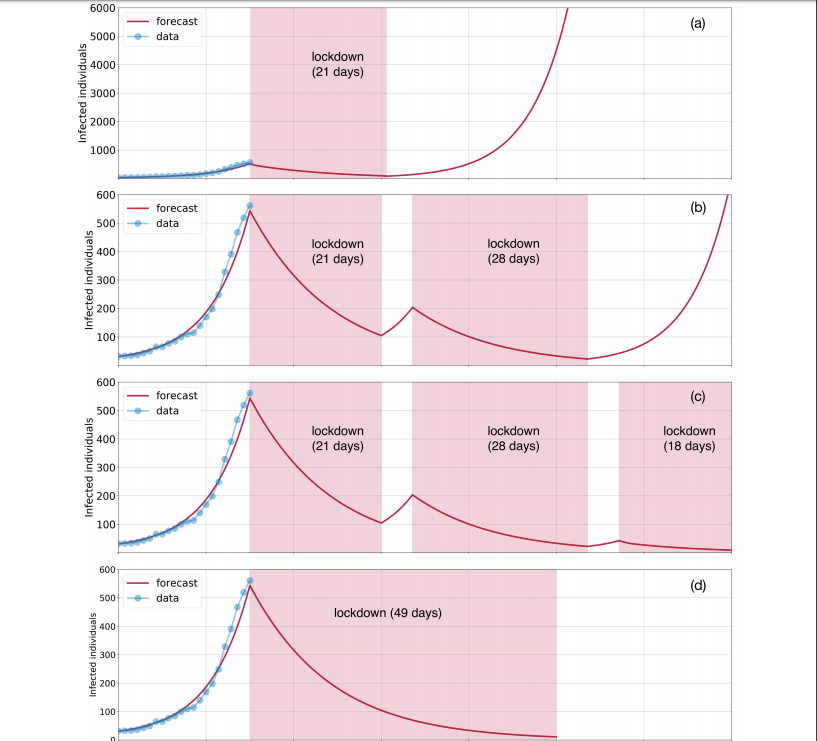We, the startup founders have a one-track mind. We tend to have a singular focus on our own startups and there is an element of it running in almost everything else we do in our lives. So much so that even routine daily problems are viewed through the startup lens. So a simple activity of grocery shopping at a time of paucity, becomes a unique “go-to-market” strategy (pun intended) to scrounge around effectively for whatever is left lying on the shelves.
If India was a startup, and the Coronavirus COVID-19 pandemic was a business impact, how would the founders deal with this setback?
Source: Shutterstock
Funds runway
A startup’s runway would be the duration for which it can exist if it continues in the same pace of revenue and cost growth. Assuming most fast-growth startups are burning money (costs are more than revenue), the runway is determined in months at which the cash balance will run out, after dipping into it every month.
The equivalent of this for India would be the duration for which the whole economy can be halted without additional revenue being generated – GDP, which is the output of the economy when it is functional.
- India is not a developed first world country to be able to go in for a complete lockdown for 60-90 days, like it is being contemplated in the UK, US and Australia. These countries are also unveiling massive stimulus packages as well as social security checks to tide the citizens over
- India is not a dictatorship (e.g., North Korea) or an autocratic (e.g., China, Russia) country, where people can be threatened with dire consequences or with a brutal 100% lockdown of infected areas even at the cost of medical services to those areas, thus sacrificing many lives in the interest of protecting the rest of the country
Thus, it is clear that India cannot afford a long, indefinite lockdown until a vaccine is found.
Facts about the Coronavirus problem
Before we get into solutioning like a startup, we need to understand the contours of the problem facing the startup. Like all founders, we have to make decisions with incomplete and/or inaccurate information, using a combination of data and instinct to navigate and survive.
Effects of lockdown on spread of infection; Source: Research report
But here are some broadly known facts:
- Prevention: The spread goes on an exponential path unless converted into a logarithmic curve through social distancing, sanitizing / washing and wearing a mask to prevent infecting others when sneezing / coughing. While there are reports that India’s mandatory BCG vaccination program to prevent TB or its climatic conditions may protect our population better than other countries, they cannot be depended upon
- Testing: There are different types of tests for detection of infection. The antibody test, which uses the presence of the antibody to COVID-19 in the body as a proxy to detect infection, is rapid, less expensive, but is also error prone. The other tests are longer, more expensive and more accurate. Either way, testing is better than watching for temperature or coughing because many people are asymptomatic in the early stages of infection
- Lifespan: The virus lifespan and efficacy depends on the surface. So plastic and steel seem to retain the virus for 72-80 hours while cardboard seems to retain for 4-6 hours as per different research reports
- Vaccination: A vaccine that works, is human-tested and can be commercially produced for the whole planet is at least 12 months away. Earliest human trials are expected to be in September 2020.
- Treatment: Some drug cocktails have shown some results in treating some conditions. For example, drugs for Malaria and HIV/AIDS treatments have worked but have an unreliable track record
- Mankind: Despite all of this, there will be a combination of idiots, religious fanatics, and the plain callous citizens who will be hell-bent on not caring for any of the rules and guidelines. They will continue to exist and be a threat to society. Assume that these are the new generation of terrorists and find a way to live
The sum total of these findings is that while a lockdown is a good solution, it is not sustainable. The economic slowdown, the resulting poverty of the most vulnerable parts of society and the long lasting impact on the psychological fabric of the typical consumer will be a triple whammy for the country. Further, even if we extend the lockdown for 60 days, even a small number of citizens who have dormant infections can restart the cycle all over again, taking the country through individual, cluster and community infections journey. Thus, the lockdown does not stand the test of a sustainable solution.
Source: Shutterstock
Managing India the startup, for 12 months
A fundamental design constraint for the solution is – the solution cannot be worse than the problem.
- Restart revenue: After 14 April, restart agriculture and factory operations with 25% workforce, mandating masks and hand sanitization at all factories. The same applies to all transportation through road, rail and air. Audit and review these facilities through factories department, agriculture / horticulture departments and transport departments. This can be for both essential and non-essential goods, to get the revenue cycle started. Mandate all factories across the country working on fabrics, to produce 500-2000 masks per month depending on their scale of operations, as found in the MSME industry department records. All staff that can work from home, e.g., technology workers, customer service, research and consulting, marketing, should all continue to work from home
- Prevent new infection sources: International travel from infection hotbeds into India to be stopped completely. All international travel from other countries into India will mandate a 14 day quarantine period upon landing in India. All domestic non-work travel to be curtailed. Travel should only be allowed for pass holders, who can get passes by raising an online request with their nearest police station and going there at the appointment time, just like one would go to a passport office. The burden of proof for getting a pass is on the citizen, and should include reasons such as medical emergency, death of a loved one and so on. All social functions to have a maximum gathering of 10 people and all religious gatherings banned and moved to virtual events using technology
- Handle growing infections: Ventilators to be manufactured on war footing, where every possible manufacturer with related equipment is converted through centralized die / mould manufacturing. Personal Protective Equipment (PPE) for all doctors and medical workers to be imported / manufactured using plastic manufacturing factories. Every district headquarters to convert local school buildings into makeshift hospitals equipped to handle up to 500 citizens while every state capital to create makeshift hospitals to handle up to 3000 citizens who are infected
- Protect the most vulnerable: Shut all schools till the age of 14 and move them to online education where the teacher teaches online in live interactive classes. Schools for those aged 15 and above will continue with 1 meter distance between classmates, and classes might have to be split into smaller batches. Continue the lockdown for all senior citizens (over 60) who have a means of income. For all below poverty line citizens, provide a direct benefits transfer to their Jan Dhan bank account. This will have to be funded by curtailing defence procurements as well as legislator salary cuts. One more fallout of the increased social isolation and infection / passing of friends and family, is the rise of anxiety, depression and other mental illnesses. Create tele-consultation hotlines staffed with trained staff who can manage and guide these citizens through therapy
Source: Shutterstock
Yes, some of these ideas may be simplistic but none of these are unrealistic, in my opinion. This might protect the country from economic downfall, while also protecting the health and welfare of citizens. It is a Hobson’s choice, and we need to make do with what we have, to come out of this on our feet, on the other side.
Please share your thoughts below.




